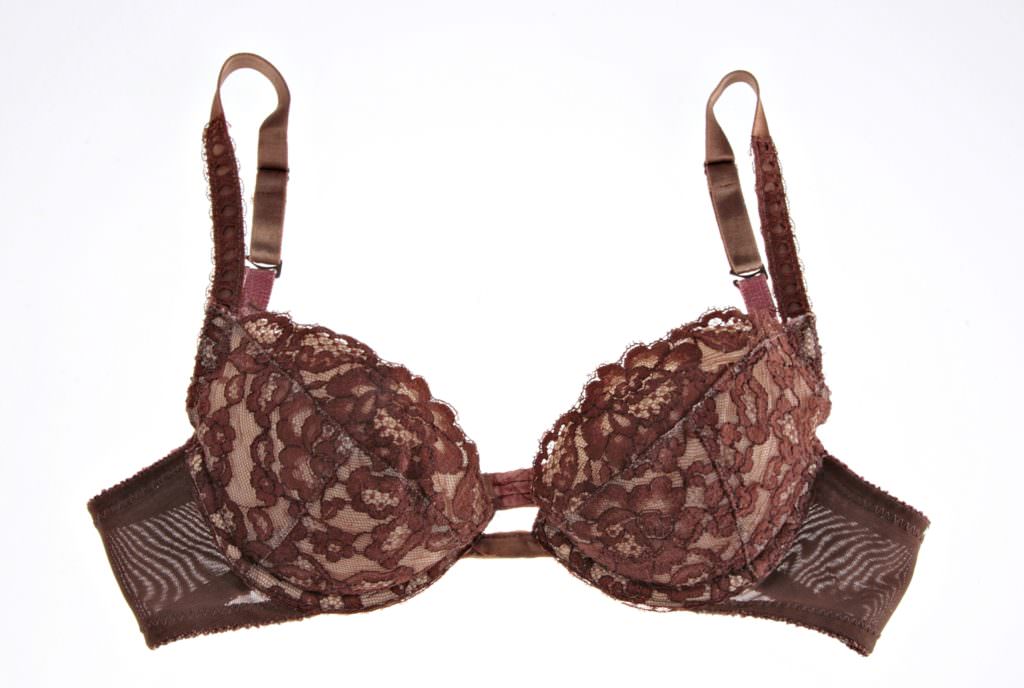From its humble beginnings in a Plateau Mont-Royal loft space, to its domination of the Canadian market, the Canadian Lady Corset Company, later Canadelle Inc., the manufacturer of the Wonderbra brand, is a little-known Montreal success story. The Wonderbra brand continues to be manufactured and sold today, with its head office in Winston-Salem, North Carolina. Between 1939 and 1980, however, the company was Montreal based and managed, and a leading innovator in the Canadian foundation wear industry.
The first Wonderbra was an American invention, created by Israel Pilot’s D’Amour Foundations in New York during the late 1930s.
He coined the name “WonderBra” for a model that featured his patented diagonal slash shoulder strap attachment. This strap, along with a bias cut cup, were features that created a comfortable brassiere style, in spite of the rationing of elastic materials during World War II.
Around the same time, Moses “Moe” Nadler founded his Canadian Lady Corset Company in Montreal. Nadler was born in Montreal in 1900 to Romanian-Jewish immigrant parents, started work at age 11, and eventually owned both dry goods stores and a women’s dress business. In 1939, believing that the brassiere business was a more stable venture, he set up an office and studio in a 4000 sq. ft. space with a few sewing machines at the corner of Mount Royal Street and St. Lawrence Boulevard.
Nadler signed a licence agreement with Israel Pilot to manufacture and sell the WonderBra in Canada; he was able to use the trade name and the diagonal slash on other products. In his design studio, he set out to diversify his product line by creating bras in the medium price range. The Petal Burst model, designed in-house, was a major success. With a concentrated advertising and promotional effort, by 1957 it accounted for 50 percent of the brassiere sales volume.
In 1964, twenty-five years after founding the company, Moe Nadler died, and his son Larry Nadler, a Harvard-trained MBA, inherited the Canadian Lady Corset Company.
Larry, who would eventually become CEO, embraced technological innovation and brought modern marketing strategies to the business.
One of the most iconic styles created by the Canadian Lady Corset Company was the Dreamlift 1300, believed to be the first Canadian-designed push-up bra.
The 1300 first appeared in the Wonderbra catalogue in 1966. It was described as “…provocative…with lowest décolletage and extra set of push up pads…to add to natural feminine charms.” Its very technical design, involving more than 50 pattern pieces, was created by in-house designer Louise Poirier.
Having understood how critical marketing was to the company’s success, Larry Nadler applied his market research results to the production of television commercials. The first such advertisement, aired in 1968, presented bras as enhancements to a woman’s allure. The innovative commercial featured the now famous jingle “We care about the shape you’re in,” sung by men. According to Nadler, it was the first to show a man in an ad for women’s undergarments and, in 1969, when Canadian television rules changed, it was the first to show a bra on a live model.

Bra, Canadelle Inc., 1965-1969. Gift of Sari Nadler, M2007.54.3 © McCord Museum
In 1968, the Canadian Lady Corset Company was sold to Consolidated Foods of Chicago (now the Sara Lee Corporation). The same year, the company changed its name to Canadian Lady-Canadelle Inc. Nadler remained president, and the Montreal company operated independently from the American head office. By 1970, Canadian Lady-Canadelle was the largest foundation wear company in Canada, with 4 plants and more than 1000 employees.
The feminist movements of the late 1960s had an enormous impact on how women viewed their foundation garments; the structured brassieres of the 1950s came to symbolize female oppression. Feminist outcry had caused widespread panic amongst foundation wear manufacturers who were worried women would abandon their bras altogether. Nadler reacted to this crisis by organizing focus groups to find out what young women actually thought of their bras and realized that “…the no-bra movement was going to manifest itself primarily as a less-bra movement.” Young women wanted lightweight, comfortable undergarments that created a natural silhouette.
At the start of the 1970s, these lightweight bras were very simple in terms of construction and made from synthetic stretch fabrics, yet all were cut-and-sewn garments. Innovative companies had already been experimenting with ways to make bras even more invisible, including hot moulding of synthetic fabrics to create a completely seamless bra cup. Around 1972, Nadler set up two task forces at Canadian Lady-Canadelle in Montreal: one dedicated to marketing a lingerie brand to young women, and a technical team to figure out a superior fabric moulding technique. The technical team pulled employees from the design, manufacturing and engineering departments.
They worked with outside textile experts, chemists and a sculptor, who was commissioned to create breast-shaped metal moulds.
In 1974, Canadian Lady-Canadelle released their seamless and moulded cup bras marketed under the brand name Dici. These bras were aimed specifically at women under 30, with the Dici name chosen for its suitability in both English and French. The slogan, “Dici or Nothing,” was developed for the brand, with an emphasis on lightness and naturalness. The bras were sold in dice-shaped boxes, which had small holes through which the customer could see and feel the product. Dici was wildly successful for Canadian Lady-Canadelle, with sales in 1976 of $21 million, double the amount for 1970. The moulding technique developed for Dici was soon applied to Wonderbra brand products as well; throughout the 1970s, moulded cups were used in bras with more structure for women needing greater support.
By 1979, Canadian Lady-Canadelle’s production and pattern making were almost entirely computerized, and the company held about 30% of the Canadian market. That same year, Consolidated Foods acquired the Hanes Corporation, and Hanes was given control of Canadian Lady-Canadelle. In 1980, Larry Nadler decided to leave the company, thus ending 41 years of Canadian ownership or management. Around this time, the company became known simply as Canadelle Inc. Hanesbrands operates offices in both Montreal and Toronto, with a distribution center located in Montreal.
Wonderbra continues to be an internationally successful brand, valued for the combination of attractiveness and practicality that characterized the earliest Montreal-made garments.
Sources
Robert Wilson, “Sales are shapely,” The Montreal Star, 6 November 1972.
Jane Farrell-Beck and Colleen Gau, Uplift: The Bra in America (Philadelphia: University of Pennsylvania Press, 2002), 106.
Israel Pilot, “United States Patent: 2245413- Undergarment,” 10 June 1941.
Larry Nadler, interview by author, tape recording, Montreal, Qc., 18 November 2015.
“« Mo » Nadler Dies After Long Illness,” Style, 1 March 1965, p. 55.
“Diagonal Slash Feature of Brassiere’s Design,” Style, 20 July 1964, p. 37.
Henry Mintzberg and James Waters, “Researching the Formation of Strategies: The History of Canadian Lady, 1939-1976,” in Competitive Strategic Management (Englewood Cliffs, NJ: Prentice-Hall, 1984), 74.
Canadian Lady Corset Co. Ltd., Wonderbra Catalogue 1966 (Montreal: Canadian Lady Corset Co. Ltd., 1966), 13.
Jerry Goodis and Gene O’Keefe, Goodis: Shaking the Canadian Advertising Tree (Markham: Fitzhenry & Whiteside, 1991), 164.
Ivor W. Boggiss, “Canadian Innerwear Makers See a Bright Future Ahead,” Women’s Wear Daily, 23 July 1970, p. 22.
Publication date
01/10/2004
Writing
Dicomode



